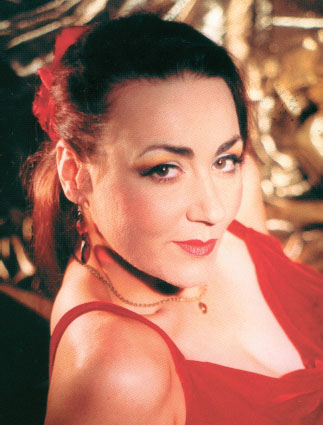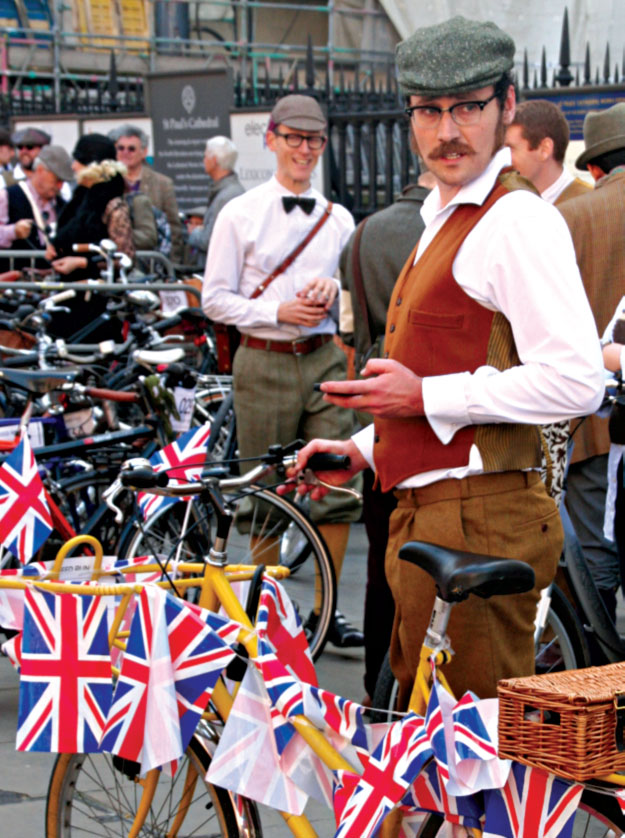
[caption id="FindingForgottenPlacesTakingTeaandTheTweedRun_img1" align="aligncenter" width="323"]

STANDING AT THE BACK of a Thames Clipper in warm sunshine, watching old warehouses, new apartments and ancient inns of the Port of London rush by, is a pleasure at any time. But when you’re dressed in tweed plus-twos, a natty diamond sweater and jaunty headscarf, pushing a trusty two-wheeled steed, it’s heaven. Tickets to the annual Tweed Run sold out in a record four and a half minutes this year, and it was only by hovering an increasingly sweaty finger over the button at 11:59 a.m., punchy with nerves, that I managed to reserve a golden ticket at exactly noon-o’clock. Hence the boat-ride to the starting post of one of the oddest events in the capital.
Five hundred sartorially immaculate chaps and chapesses enter the Tweed Run each year, a leisurely 10-mile bicycle ride taking in the classic sights of traditional London. St. Paul’s Cathedral, Buckingham Palace and The Houses of Parliament, not to mention Jermyn Street and Saville Row, are all enjoyed at a sober speed, with tea breaks every so often to decide the winners in the “most dapper chap” or “best doffed cap” competitions.
Most people rode vintage velocipedes, everything from enormous penny-farthings to hefty butchers’ bikes, though I slipped in quietly on my 2008 Marin. Music was of the currently-cult “Chap-Hop” variety: a strange melange of upper-class rap and 1930s dance-band scratch mix, all blaring from a wireless on the back of a trike. One young fellow had a real piano mounted on a bicycle, which required pedalling sideways as he played, and yet another had a gramophone player (with horn) strapped to the front of his contraption. Later, I enjoyed an entire jazz band complete with double bass, banjo and trombones, being ferried in two decorated rickshaws. One of the stranger sights in London, if the Tweed Run is not the best thing I’ll do this year, then I have some fine moments to look forward to. The event is open to all, but sign up in advance, so you know when to hover, sweaty-digited, over the return-key. Those tickets go fast.
[caption id="FindingForgottenPlacesTakingTeaandTheTweedRun_img2" align="aligncenter" width="625"]

TONY MITTON
AFTER ALL THAT, a nice cup of tea and a sit down was in order. I am a huge fan of afternoon tea, but it can so often be a flat experience in London. Some of the worst offenders are the major hotels, who have sunk to giving the least possible service for the most possible guests. Coachloads of unsuspecting tourists are seated at inelegant speed, plates of merely acceptable sandwiches and cakes dumped on their table. They’re then chivvied along to finish up as soon as possible, ready for the next batch—all for often upwards of 40 to 50 pounds. If you want Champagne with that, you can cough up an extra 20-odd quid in some places. So, I’m always on the lookout for off-piste venues which may not be so glamorous as the big-hitters, but give something else in return—value for money—and that feeling that you’ve “found a gem.”
You would walk straight past Tea & Tattle. Even though it’s directly opposite the British Museum, even in the mid-afternoon, this little basement café is almost undetectable. It’s below an antiquarian Oriental and African bookstore, and until relatively recently was a storeroom, packed to the gills with unsold volumes. It’s been cleared out, delicately redecorated with chinoiserie-style wallpaper and is now a dainty, surprisingly light-filled haven.
I took Mum and Dad there, intending to have the classic afternoon tea. But when I saw the menu, I realised I could order à la carte and still have a splendid sugary hit at about half the price. The waitress confided that “most people do that…”
You’re not going to get your crusts cut off for you here. The sandwiches are on the interesting bread of your choice and are generously filled. Cakes are big slices of gooey-topped gateaux and the scones come ready cream-and-jammed, saving you the age-old worry of whether it’s a faux-pas to get the cream and jam round the “wrong” way. This is not a conventional afternoon tea—but the three of us ate far more than we could really manage, felt rather exclusive, and came away having spent about £25 between us. All this not 50 yards from the gates of the British Museum. Visit before everyone else finds it.
SOME PLACES ARE SO SECRET that even their owners don’t know they’re there. When Conran bought the dishevelled Great Eastern Hotel at Liverpool Street in the 1990s, intending to totally refurbish, there was an intriguing void in the middle of the floorplan. It was only on finding the relevant key to a dusty, forgotten doorway in a disused area that the “void” turned out to be an extraordinary art nouveau Masonic temple, built by Charles Barry Jr., son of the Houses of Parliament architect. Created in lavish marble, mahogany and gold, it’s a jewel box of exquisite proportions, severe majesty and heavy symbolism. Everything was still in place when the developers rediscovered it, from specially-made opaque glass lanterns to the magnificent organ.
Today, the temple has been completely restored, from its marble columns to its sunken chequerboard floor, from the sparkling golden sunrays in the ceiling’s heart to the rows of leather, high-backed thrones, and is mainly used for swanky functions—though freemasons still meet there on special occasions. The hotel, now the Andaz, is a rather quirky mixture of high-Victorian splendor and ultra-modern styling (I spent some time looking for the front desk, before realising that there isn’t one; it’s all done by personal greeters and computers). Guests can hope to sneak a peek around the door of the temple if there’s no function, but a more reliable way to see it is on Open House Weekend.
ALSO BEST VIEWED at Open House is the Lloyds Building. This brave piece of modern architecture divides opinion and taunts debate, but to know it is to love it, and it, too, has a little secret of its own. Built to maximize interior space, all the utilities, from the elevators to the plumbing, are outside the building. This, of course, gives sleek lines inside, but means that everyone else has to look at the building’s less-attractive assets. After having been inside, though, I have finally learned to love it.
The central atrium is worth a gawp in itself, but most visitors make a beeline for the Lutine Bell, rescued from a wreck in 1858. It was traditionally rung for the loss of a ship, and when it sounded, the whole floor would stop, hoping for a second chime, which meant a ship had been recovered. Nearby lives the famous book, in which every major loss is still recorded in ink, and a small collection of Titanic memorabilia, from one of their less-profitable underwritings. But the sight no visitor should miss is tucked away on an upper floor and is a real surprise. In the middle of one of the most modern buildings in the City, a door opens onto a genuine 18th-century dining room by Robert Adam. Originally created for Bowood House in Wiltshire, the Adam Room came up for auction when a large part of the house was demolished (back in the 1950s when people did such things). The chap from Lloyds, who’d only gone to the auction to buy the fireplace, purchased the whole room, which made its way into the modern incarnation. A white and pale green confection of delicate plasterwork and sparkling chandeliers, the room is all the more enjoyable for its stark setting.
[caption id="FindingForgottenPlacesTakingTeaandTheTweedRun_img3" align="aligncenter" width="1024"]

COURTESY OF THE ANDAZ HOTEL
THE CITY OF LONDON Police Museum, another secret within a building, this time Wood Street Police Station, had been closed for years, and I only phoned up to see if there had been any movement on its status. I was lucky enough to catch its new, very enthusiastic curator, Catherine Coulthard. She explained that though she can’t open all the time, she is only too delighted to arrange a personal tour around what has to be one of the tiniest (but most fascinating) museums in London for anyone who calls ahead. In a whirl, Coulthard whisked me on a tour of policing in the City, from the early night watchmen or “Charleys” through the first Bobbies, to the modern police service. There are bits covering the notorious Siege of Sidney Street (including a remarkable photograph of a nosy crowd of onlookers headed by none other than a young Winston Churchill) and the grisly Houndsditch Murders. This is more about the force than its cases, though, and includes an eclectic collection of memorabilia from truncheons to call boxes. It hadn’t occurred to me that I was actually interested in the history of policing, until I realised it had taken more than an hour to cover a museum that can’t be bigger than a couple of overnight cells.
THIS MONTH’S CONTACTS
The Tweed Run
www.tweedrun.com
Tea & Tattle
41 Great Russell Street, WC1B 3PE www.apandtea.co.uk
Masonic Temple Andaz Hotel www.london.liverpoolstreet.andaz.com
Adam Room Lloyds of London www.lloyds.com
City of London Police Museum call Catherine Coulthard on 0207 601 2328
Next time, I’ll be putting student chefs through their paces, going underground with Alexander Pope and taking a stroll through Occult London.





Comments